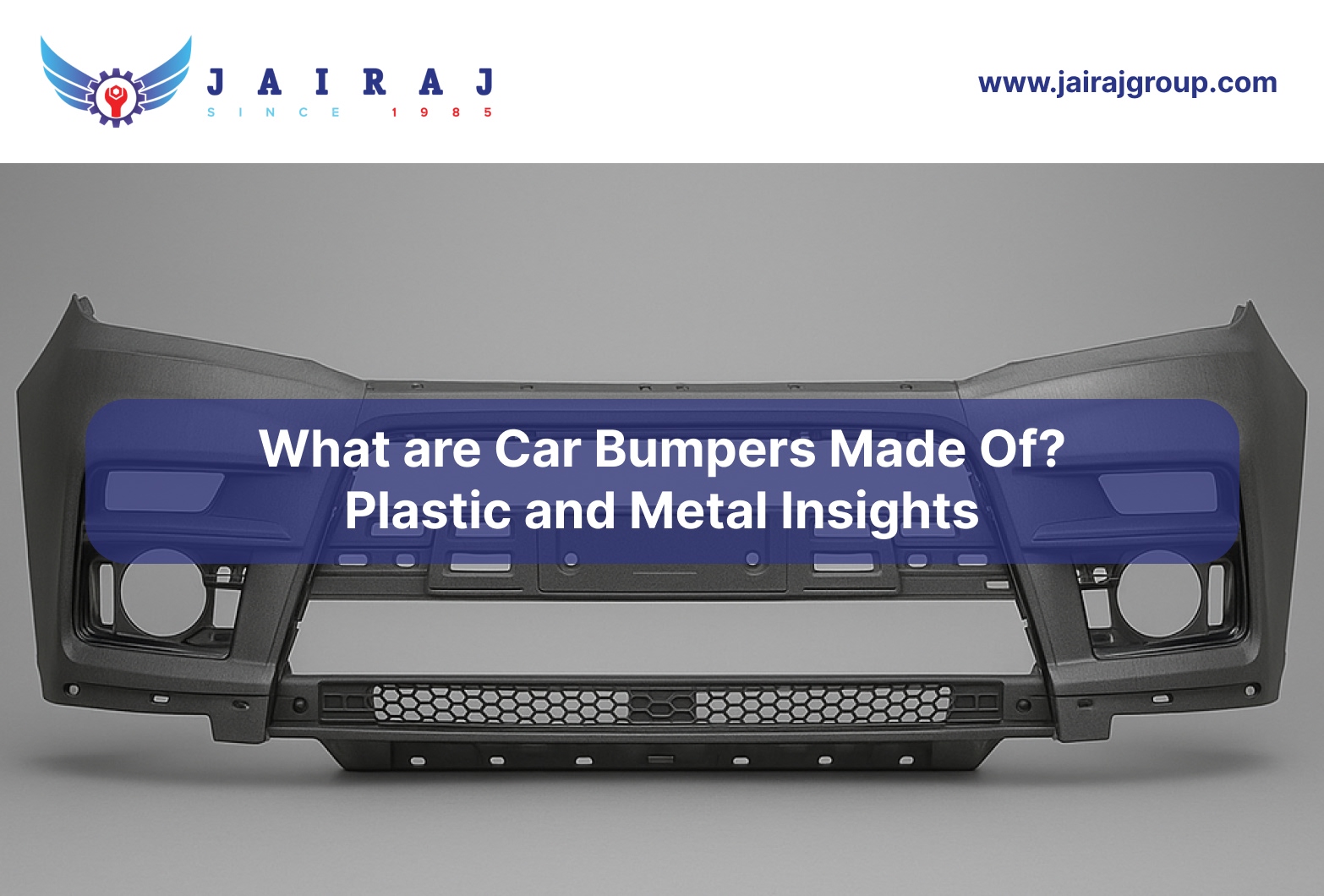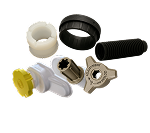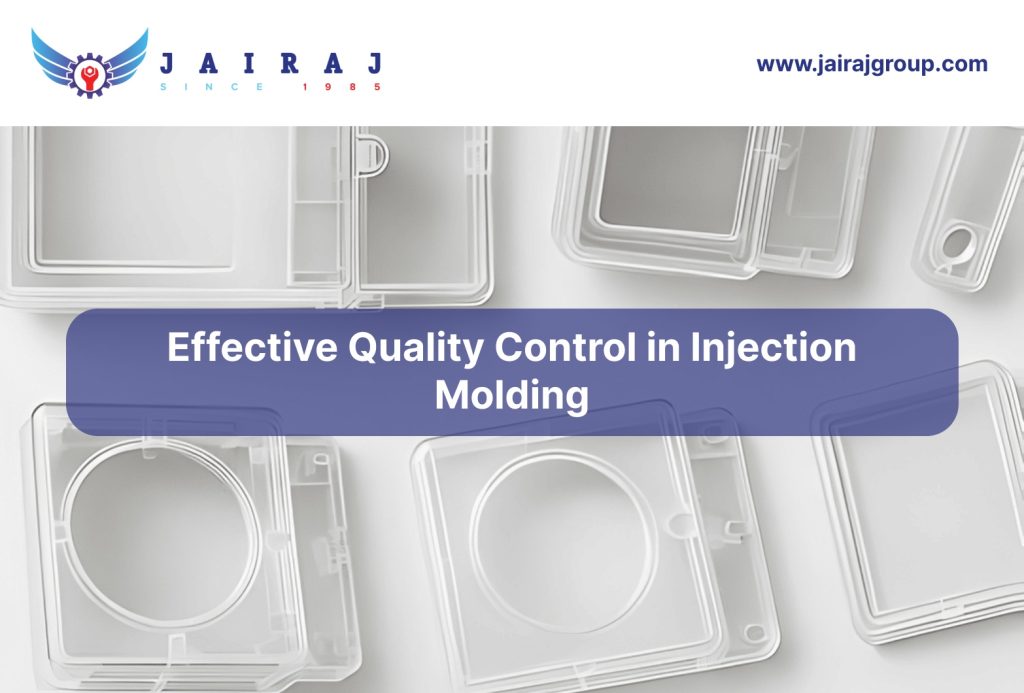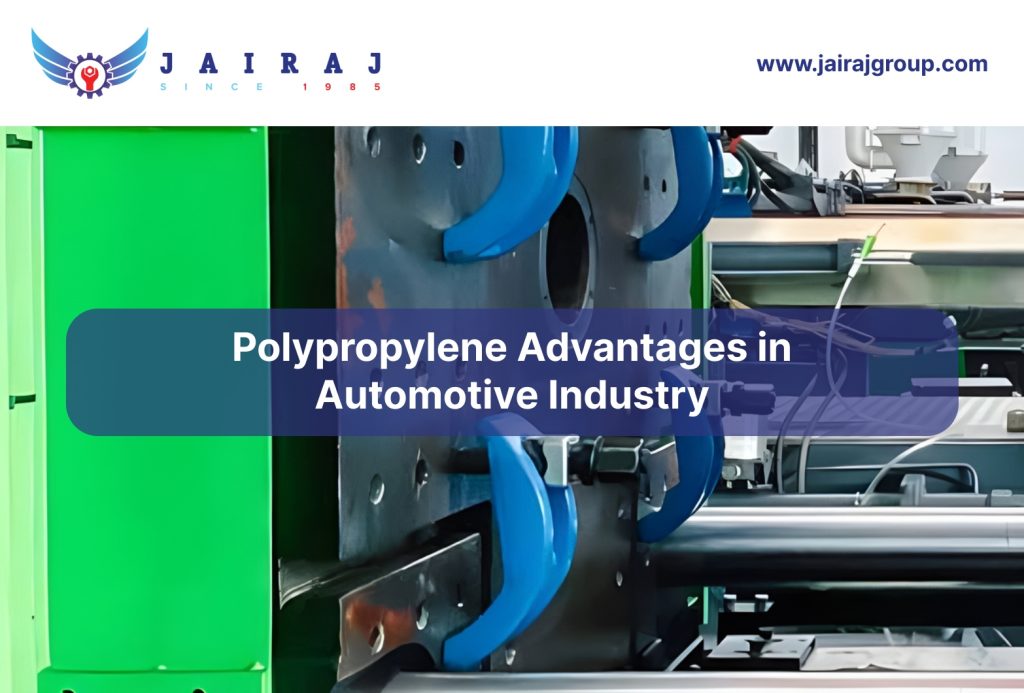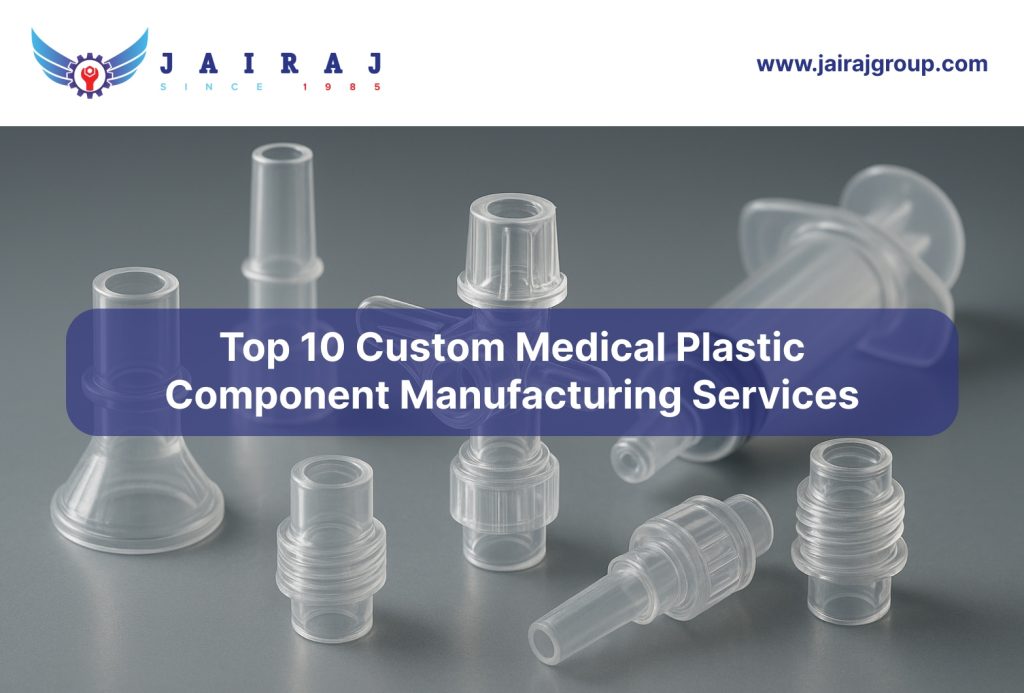When it comes to automotive safety and design, car bumpers serve a critical role in absorbing impacts during collisions and protecting the vehicle from external damage. So, what are car bumpers made of?
Traditionally, bumpers have been constructed from metal, but advancements in materials science have led to the widespread use of plastics and composites. Today, most modern car bumpers are made of a combination of plastic materials, including polypropylene, ABS (Acrylonitrile Butadiene Styrene), and other advanced polymers.
With the global automotive plastic bumper market projected to reach USD 20.2 billion by 2035, rising SUV and EV demand and stricter crash safety standards continue to drive innovation in lightweight, high-performance bumper materials.
This blog will explore what car bumpers are made of, focusing on the various plastic materials used in their manufacturing, the benefits of custom plastic bumpers, and the overall functionality of bumpers in automotive manufacturing.
Key Takeaways
- Plastic bumpers offer lightweight, durable solutions that enhance vehicle performance and safety.
- Materials like polypropylene and ABS are commonly used for their impact resistance and moldability.
- Custom plastic bumpers can reduce vehicle weight, improving fuel efficiency and energy consumption.
- The use of plastic components in bumpers allows for greater design flexibility and aesthetic appeal.
- Plastic bumpers play a key role in pedestrian safety by absorbing collision energy and reducing injury risks.
What is a Car Bumper?
A car bumper is a structure attached to both the front and rear of a vehicle to absorb the impact of collisions. The bumper plays a key role in minimizing damage to the vehicle, protecting its structural integrity, and ensuring the safety of both passengers and pedestrians.
In addition to its protective functions, the bumper also contributes to the vehicle’s aesthetic design, with manufacturers aiming to balance functionality with visual appeal. While bumpers are designed to withstand minor collisions, they are also an important component in energy dissipation during higher-impact accidents.
At Jairaj Group, we use Polypropylene (PPCP) and ABS+PC blends for car bumpers that meet global OEM standards, ensuring exceptional impact resistance and heat stability. Our Plastic Injection Molding technology delivers precision-molded Bumper Caps and Exterior Automotive Accessories with consistent strength and lightweight balance. Using computer-aided mold design and flow simulation, we maintain uniform wall thickness and eliminate defects like sink marks.
Beyond function, custom plastic bumpers offer a range of performance and design benefits.
Benefits of Custom Plastic Car Bumpers for the Automotive Industry
Custom plastic bumpers offer several benefits over traditional metal bumpers. These advantages make them the preferred choice for many automotive manufacturers:
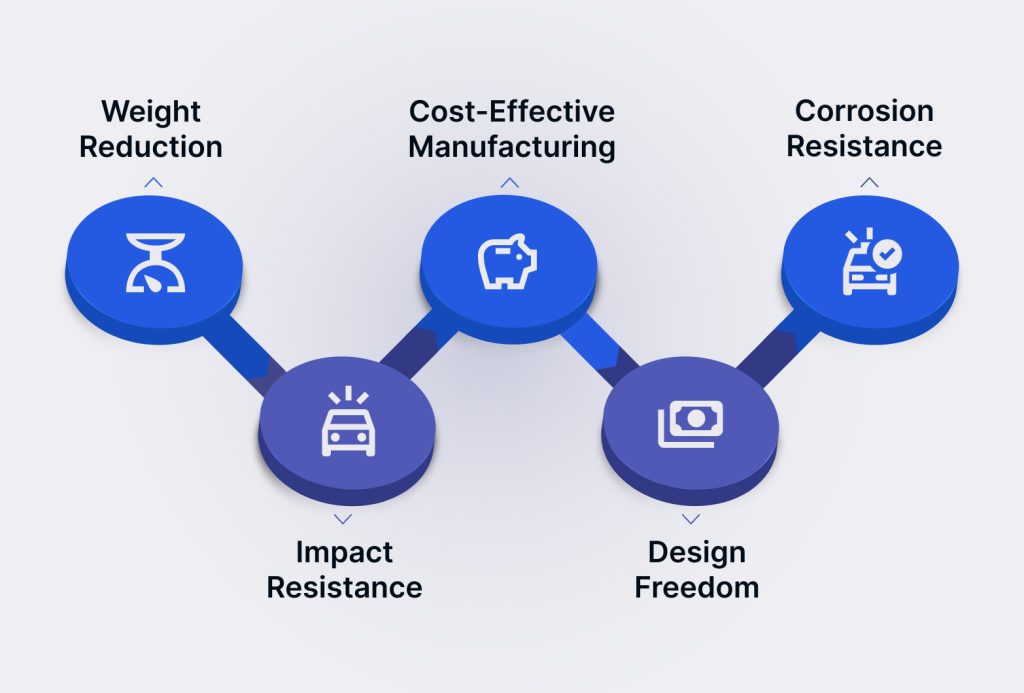
Weight Reduction
Plastic bumpers are significantly lighter than metal bumpers, reducing the overall weight of the vehicle. This weight reduction is especially important in electric vehicles (EVs), where every kilogram saved directly improves range and energy efficiency.
Impact Resistance and Flexibility
Plastic bumpers are more flexible and better able to absorb impact than metal bumpers. They can bend and deform without cracking, which helps protect both the vehicle and its occupants during low-speed collisions.
Cost-Effective Manufacturing
The manufacturing process for plastic bumpers is typically less expensive than for metal bumpers. Plastic materials are easier to mold and form, reducing production time and labor costs. Additionally, plastic bumpers can be made with lower material costs.
Design Freedom
Plastic bumpers offer more design flexibility than metal bumpers. Automotive manufacturers can mold plastic into intricate shapes and designs, enhancing the vehicle’s aesthetic appeal while maintaining functionality.
Corrosion Resistance
Unlike metal bumpers, plastic bumpers are not prone to rust or corrosion. This makes them a more durable and long-lasting solution, especially in harsh weather conditions.
Also Read: Complete Guide to Thermoforming: Process and Applications
Manufacturers can further optimize performance by understanding the various types of bumpers used today.
Types of Car Bumpers in Automotive Production
Car bumpers come in various styles and designs, each serving a specific purpose in terms of functionality, aesthetics, and protection. Below are some of the most common types of car bumpers used across industries:
Standard Bumper
The standard bumper is commonly used in passenger cars and light trucks. Made from polypropylene or TPO, it offers durability, flexibility, and energy absorption in low-speed collisions. These bumpers balance protection and aesthetics, making them suitable for everyday vehicles.
Cowboy or Deep Drop Bumper
Found in pickup trucks and SUVs, the cowboy bumper extends downward for increased ground clearance. Typically made from steel or high-strength polymers, it provides superior impact resistance and is ideal for off-road vehicles or trucks used in rugged environments.
Step Bumper
The step bumper features a built-in step, offering easy access to the truck bed or cargo area. Often used in pickup trucks and commercial vehicles, it’s made from metal alloys or reinforced plastic, providing durability and functionality for cargo handling and loading.
Tube Bumper
Popular in off-road vehicles, the tube bumper is made from metal tubing such as steel or aluminum, providing rugged strength. Known for impact resistance and aesthetic customization, it’s designed for tough environments and off-road conditions, offering a blend of style and functionality.
Roll Pan Bumper
The roll pan bumper replaces traditional bumpers with a smooth panel, giving a sleek, customized look. Common in custom vehicles, it prioritizes aesthetics over protection but can be paired with hidden tow hitches for added practicality in modified trucks and builds.
Also Read: Complete Guide to Thermoforming: Process and Applications
These designs depend heavily on the materials used in production, which influence both strength and efficiency.
4 Main Types of Car Bumper Materials Used in Automotive Manufacturing
Automotive manufacturers typically use several types of plastic for car bumpers. These plastics are carefully selected based on the balance between impact resistance, weight, cost, and moldability. Some common types of plastic used in bumper manufacturing include:
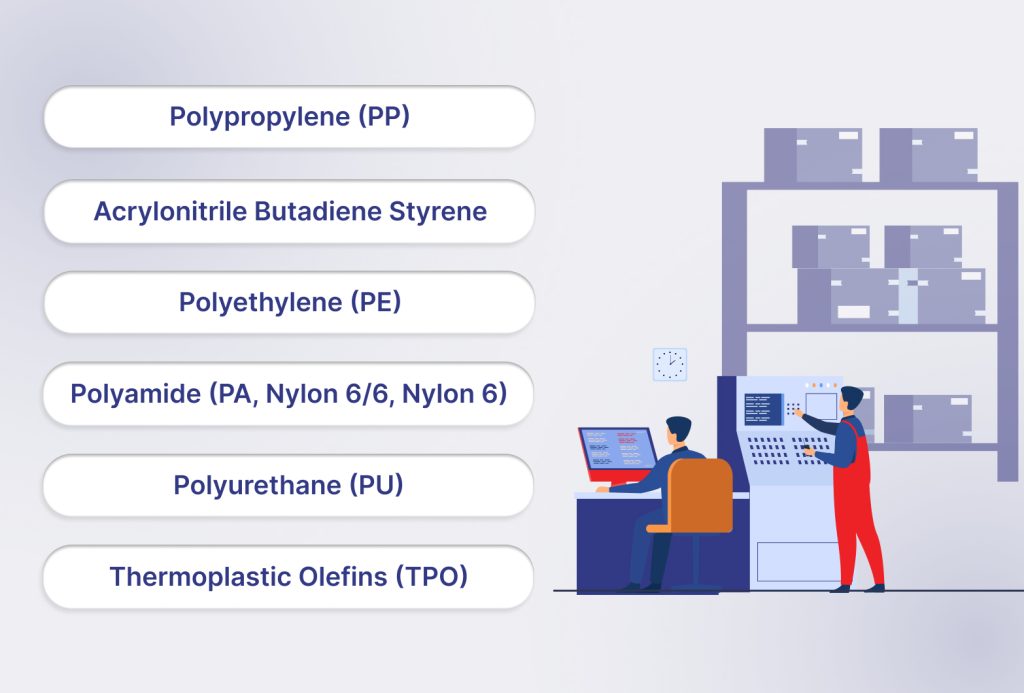
Polypropylene is one of the most commonly used materials for car bumpers. It is lightweight, flexible, and resistant to impact and chemicals, making it ideal for absorbing collision forces. Its ability to be molded into complex shapes also adds to its popularity in bumper production.
ABS is another popular material due to its excellent toughness and impact resistance. It offers superior performance in terms of durability and surface finish, making it ideal for visible parts of the bumper. ABS is also easy to paint, making it suitable for aesthetic purposes.
Polyethylene (PE)
Polyethylene is valued for its excellent impact strength and flexibility, making it ideal for car bumpers that must absorb and distribute collision energy effectively. Its resistance to low temperatures and chemical corrosion ensures long-term durability in harsh environmental conditions.
Polyamide (PA, Nylon 6/6, Nylon 6)
Polyamide, commonly known as Nylon, is favored for its superior tensile strength and rigidity. It maintains structural stability even under high stress and heat, which is critical for high-performance bumper assemblies that demand precision, durability, and consistent finish.
Polyurethane (PU)
Polyurethane is used in certain bumpers, especially in applications that require high energy absorption and flexibility. It is often used in the core structure of bumpers to enhance energy dissipation during low-speed collisions.
Thermoplastic Olefins (TPO)
TPO is increasingly used in bumper manufacturing for its blend of impact resistance and recyclability. It also provides a smooth finish, which is ideal for aesthetic applications. TPO is known for being durable in extreme temperatures and is easy to process.
Also Read: Injection Moulding Plastic Components Manufacturer and Exporters in India
Each bumper also comprises multiple plastic components engineered for precision and endurance.
What are the Plastic Components Manufactured for a Car Bumper?
In addition to the main bumper structure, several other components are made from plastic for the bumper assembly. These components include:
Bumper Cover
The bumper cover is the outermost part of the bumper assembly. Made from plastics such as polypropylene or ABS, it provides the vehicle’s aesthetic appearance and protects the underlying bumper structure.
Energy Absorbers
Energy absorbers are designed to absorb the energy generated during a collision. These components are often made of foamed plastic, such as polyurethane, which helps dissipate the force and reduce damage to the vehicle.
Bumper Reinforcements
Bumper reinforcements are essential for adding structural integrity to the bumper. They are often made from high-strength plastics or composites, designed to withstand heavier impacts and provide additional protection.
Bumper Grilles and Air Dams
Bumper grilles and air dams, often made from plastic, provide the necessary airflow to the vehicle’s engine while also contributing to the vehicle’s aesthetic design. These components are usually made from materials like TPO or ABS.
Sensors and Wiring Holders
Many modern bumpers are equipped with sensors, cameras, and wiring for safety and assistance features like parking sensors and collision detection. Plastic components are used to house and protect these sensors and wiring, ensuring their proper function.
Also Read: Automotive Injection Molding Guide for Cost Optimization and Supplier Strategy
Together, these parts perform critical functions essential to vehicle safety and compliance.
Functions of a Car Bumper in Automotive Manufacturing
The functions of a car bumper extend beyond just protection. Bumpers play several crucial roles in vehicle design and manufacturing:
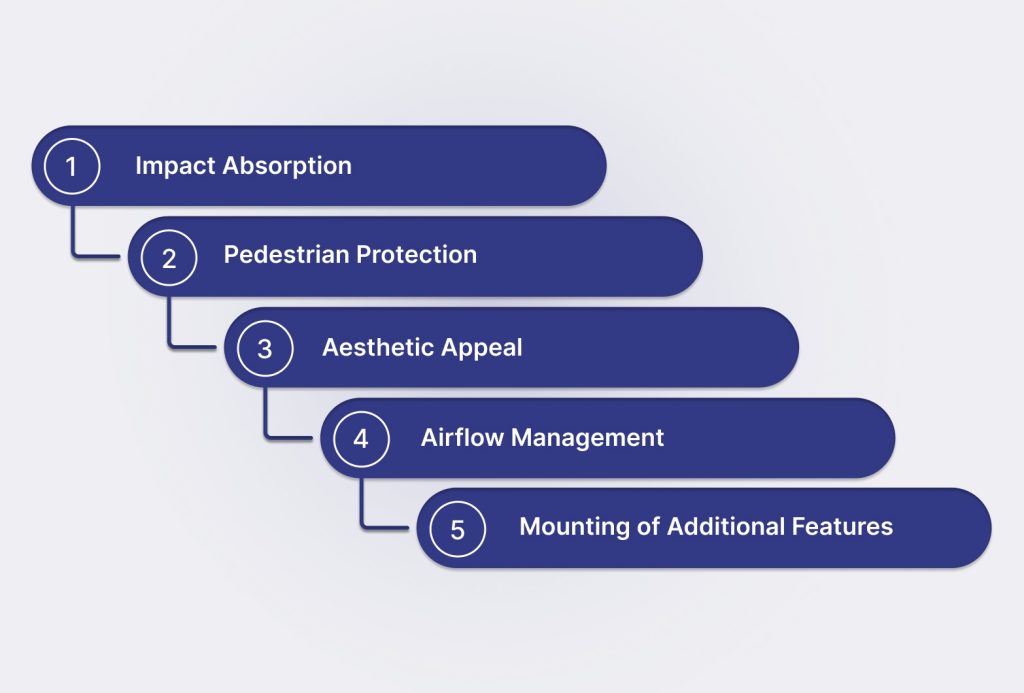
Impact Absorption
Bumpers are primarily designed to absorb the energy from low-speed collisions, minimizing damage to the vehicle’s frame and safety systems. The flexibility and shock-absorbing properties of plastics make them an ideal material for this function.
Pedestrian Protection
Bumpers also serve to protect pedestrians in the event of a collision. Plastic bumpers, especially those made with energy-absorbing materials, help minimize injury in low-speed accidents by providing a softer impact surface.
Aesthetic Appeal
In addition to their protective function, bumpers are a key aesthetic feature of a vehicle. Plastic allows for greater design flexibility, enabling manufacturers to create stylish and streamlined bumpers that enhance the overall look of the vehicle.
Airflow Management
Bumpers often house air intakes and vents to improve the vehicle’s aerodynamics and cooling efficiency. Plastic bumpers allow for precise design and integration of these airflow management systems.
Mounting of Additional Features
Modern bumpers are often equipped with sensors, cameras, and other high-tech systems for parking assistance, collision avoidance, and other safety features. Plastic components are ideal for securely mounting and protecting these technologies.
Also Read: Top Plastic Manufacturers in 2025
For manufacturers aiming to improve these functions, collaboration with a specialized plastics partner is vital.
Improve Car Bumper Performance with a Reliable Manufacturing Partner
Car bumpers often use plastic components due to their flexibility, durability, and cost-effectiveness. At Jairaj Group, we manufacture a wide range of precision-engineered plastic components, ensuring the highest standards for automotive and other industries.
With over 35 years of expertise, our products support OEMs, Tier-1 suppliers, and specialized manufacturers across diverse sectors such as automotive, aerospace, defense, and heavy equipment. From bumpers to braking systems, our advanced manufacturing technologies deliver top-tier quality and performance.
Here’s why Jairaj Group is your ideal partner for precision-engineered car bumpers:
Plastic Bellows & Struts: Used in automotive, two- and three-wheelers, railways, and heavy-duty vehicles, Jairaj Group’s plastic bellows and struts ensure durability, flexibility, and resistance to harsh conditions. These parts are engineered to absorb vibrations and protect critical components, making them ideal for bumpers and suspension systems.
Brake & Accelerator Pedals: Manufactured using high-strength plastic materials like ABS and polypropylene, our brake and accelerator pedals provide the necessary durability and impact resistance for automotive, two-wheelers, and heavy-duty vehicles. These components are designed for safety and long-lasting performance.
Shockers & Suspension Components: Jairaj Group’s shockers and suspension components are made from advanced polymers that ensure maximum impact resistance and structural integrity. These parts are used across automotive, railways, and heavy-duty vehicles to provide smooth rides and prevent damage during high-stress conditions.
Roto Moulding Components: Our roto moulding components, ideal for automotive, aerospace, and defense, provide flexibility in design while ensuring the parts are durable and resistant to environmental stress. We offer solutions for everything from bumpers to components used in extreme conditions, offering superior performance and reliability.
Interior & Exterior Accessories: From bumpers to trims and structural elements, our plastic components, including those made with TPO, ABS, and Polycarbonate, are designed for aesthetic appeal as well as high durability. These parts are used in automotive, white goods, aerospace, and defense, ensuring both functionality and style.
Precision Components from Advanced Polymers: Jairaj Group produces precision components using high-performance polymers like PBT Arnite and Nylon 6/66 for automotive, aerospace, and defense sectors. Our products, including fuel line connectors and bumper caps, are engineered for superior reliability and resistance in critical applications.
Jairaj Group’s rigorous quality control and custom design capabilities meet the strictest automotive standards, delivering reliable and high-performance solutions for the automotive and mobility sectors.
Conclusion
By utilizing materials like polypropylene, ABS, and polyurethane, manufacturers can create bumpers that protect the vehicle and enhance its performance and aesthetics. The ability to customize plastic bumpers for different vehicle types, such as electric cars, two-wheelers, or heavy-duty vehicles, makes them an indispensable component in automotive manufacturing.
Jairaj Group manufactures precision plastic car bumpers at facilities in Rudrapur, Aurangabad, and Sanand. Using injection molding, blow molding, and rotational molding, we ensure high-impact resistance and thermal stability for meeting the rigorous safety standards in the automotive industry. Our advanced molding techniques optimize material distribution, preventing defects like warping and sink marks.
Contact Jairaj Group to discover how our high-performance car bumpers can upgrade your automotive manufacturing.
FAQs
1. What is the primary material used for car bumpers?
Car bumpers are typically made from polypropylene (PP), ABS, and polyurethane, offering a combination of lightweight, impact resistance, and flexibility.
2. Why are plastic bumpers preferred over metal ones?
Plastic bumpers are lighter, cost-effective, more flexible, and offer better impact resistance, making them ideal for reducing vehicle weight and enhancing safety.
3. Can plastic bumpers be recycled?
Yes, materials like polypropylene and TPO used in plastic bumpers are fully recyclable, contributing to sustainable automotive manufacturing.
4. How do plastic bumpers protect against pedestrian injuries?
Plastic bumpers absorb impact energy and are designed to soften the blow during low-speed collisions, reducing pedestrian injury.
5. What are the benefits of custom plastic bumpers?
Custom plastic bumpers offer improved weight savings, enhanced impact resistance, and design flexibility, allowing manufacturers to meet specific performance and aesthetic goals.
6. Are plastic bumpers used in electric vehicles?
Yes, plastic bumpers are widely used in electric vehicles (EVs) for their lightweight properties, helping to improve range and efficiency.

